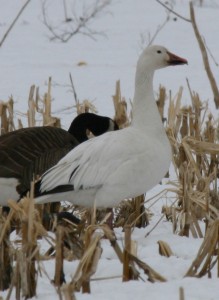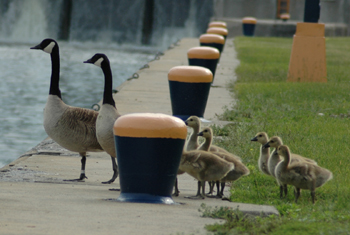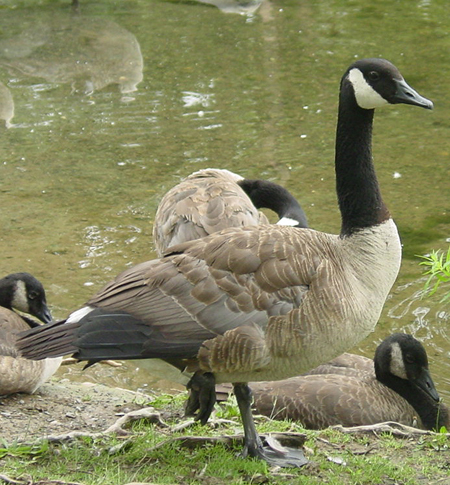Snow Goose
General:
The Snow Goose has two color plumage phases, white (snow geese) or gray/blue (blue geese). The dark color of the blue morph Snow Goose is controlled by a single gene, with dark being  partially dominant over white.(1) Scientists used to believe these were separate species but now consider the birds the same. White and blue phase birds interbreed and the offspring may be either white or blue.
partially dominant over white.(1) Scientists used to believe these were separate species but now consider the birds the same. White and blue phase birds interbreed and the offspring may be either white or blue.
Snow Geese mate for life. Nesting usually begins at the end of May. They make a shallow ground nest lined with down. The female produces two to six whitish eggs. Incubation takes about 23-25 days, they fledge in 45-49 days. After hatching, the young are covered with down and eyes open. The chicks feed themselves but are protected by both parents. Parents stay with their young through the first winter.
Here is an interesting fact: Snow Geese and Ross’s Geese can breed. I have read that they can also breed with Greater White-fronted Geese, Canada Geese, and Cackling Geese.
These geese are known to gather in massive flocks.
Identification:
The Snow Goose is a medium-sized goose. They are 22” – 30” long with a wing span of 54″ – 59”. They weigh approximately 4 -6 lbs. Snow geese have two phases – “white” and “blue”. The White Goose as the picture indicates is white except for black wing tips. This phase is more common in the east. The blue phase has bluish-grey plumage replacing the white except on the head, neck and tail tip. This phase is common on the Gulf coast and West.
Both snow and blue phases have rose-red feet and legs, and pink bills with black tomia (“cutting edges”), giving them a black “grin patch.”
Habitat:
In breeding season – on subarctic and arctic tundra, near ponds or streams. In winter – in coastal marshes and bays, wet grasslands, freshwater marshes, and cultivated fields.
Territory:
The snow goose breeds north of the timberline in Greenland, Canada, Alaska, and the northeastern tip of Siberia
Migration:
The Snow Goose migrates from its breeding grounds to warmer parts of North America from southwestern British Columbia into parts of the United States and Mexico mostly in salt marshes and coastal bays. Snow Geese travel south in very large, high-flying flocks.
Hunting:
In 1916, snow geese had become so rare in the eastern United States that hunting of the species was banned. Today the snow goose population is strong and growing. So strong in fact that New York has a spring hunting season. The birds have become so numerous in places that they threaten to destroy their own habitat. I do not remember seeing snow geese in eastern New York 20 years ago, now they are common during migration. Hunting is typical goose hunting – field hunting with decoys works well. The meat of snow geese is good. Do not miss an opportunity to hunt these birds. The shooting is fast and fun.
Food:
Marsh plants, field grain – corn, rice, wheat, etc
 tipping forward like a dabbling duck. Flocks of these birds often feed on leftover cultivated grains in fields, especially during migration or in winter.
tipping forward like a dabbling duck. Flocks of these birds often feed on leftover cultivated grains in fields, especially during migration or in winter. ith one parent at the front, and the other at the back of the “parade”. While protecting their young, parents often violently chase away nearby creatures, from small blackbirds to other geese, to humans that approach, after warning them by giving off a hissing sound. However, geese may form groups of a number of goslings and a few adults, called crèches. The young do not leave their parents until after the spring migration, when they return to their birthplace.
ith one parent at the front, and the other at the back of the “parade”. While protecting their young, parents often violently chase away nearby creatures, from small blackbirds to other geese, to humans that approach, after warning them by giving off a hissing sound. However, geese may form groups of a number of goslings and a few adults, called crèches. The young do not leave their parents until after the spring migration, when they return to their birthplace. except the Barnacle Goose, but the latter has a black breast, and grey, rather than brownish, body plumage. There are seven subspecies of this bird, of varying sizes and plumage details, but all are recognizable as Canada Geese. Some are hard to distinguish from the Cackling Goose (Branta hutchinsii), with which the Canada Goose was long assumed to form one species; the name Lesser Canada Goose is, confusingly, often applied to B. hutchinsii.
except the Barnacle Goose, but the latter has a black breast, and grey, rather than brownish, body plumage. There are seven subspecies of this bird, of varying sizes and plumage details, but all are recognizable as Canada Geese. Some are hard to distinguish from the Cackling Goose (Branta hutchinsii), with which the Canada Goose was long assumed to form one species; the name Lesser Canada Goose is, confusingly, often applied to B. hutchinsii.